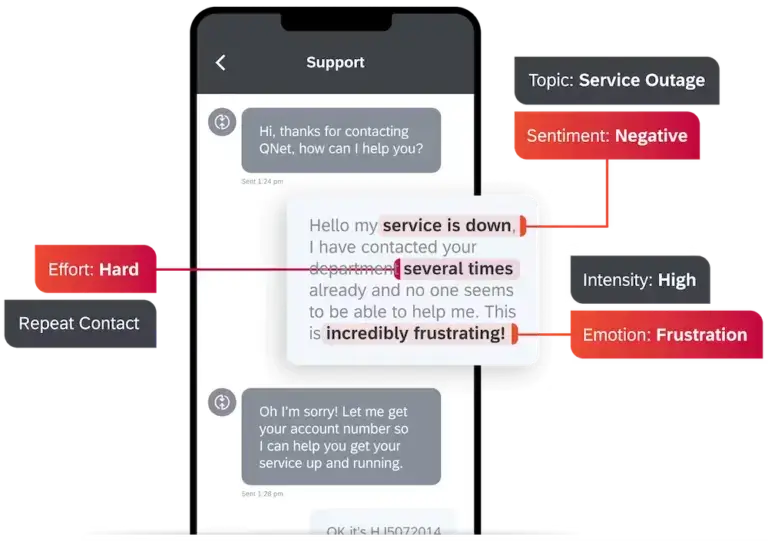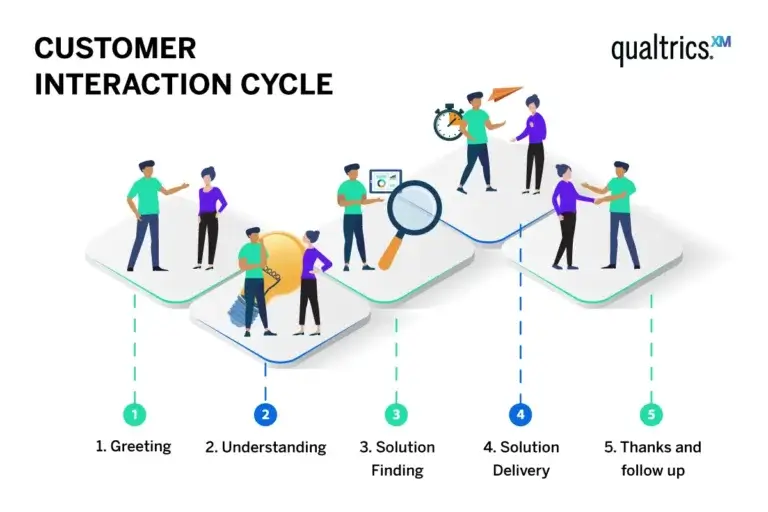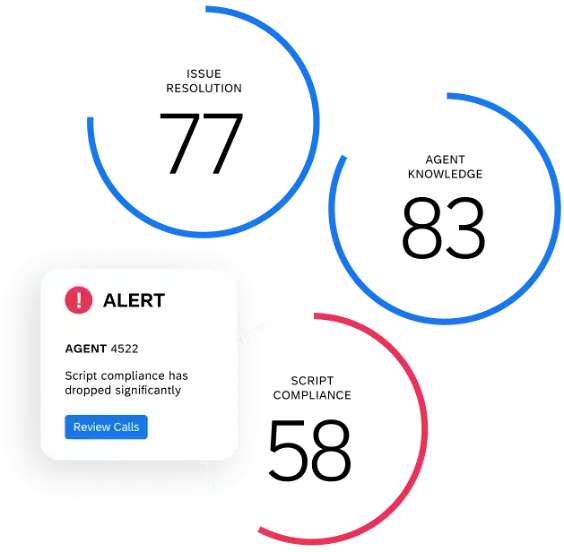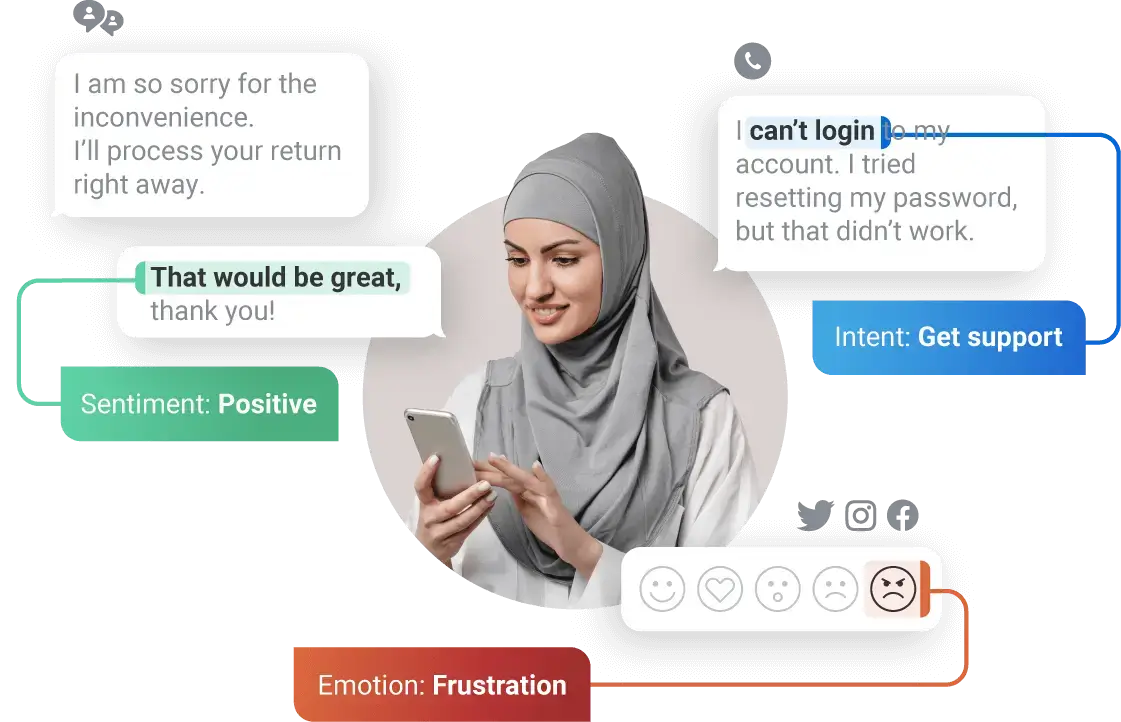Author: Adam Bunker
Subject Matter Expert: Leonie Brown
What is a customer interaction?
The term ‘customer interaction’ defines any point at which a potential or existing customer communicates with your business. That could be for any number of reasons, and on any number of channels, including:
- A customer speaking with the contact center via call, email, or live chat
- Replying to a post on social media
- A sales call or demo
- An in-person visit to a physical location
Because the exact nature, reason, and outcome of each of these moments can be pretty wide-reaching, it’s important to understand not only why customer interactions happen, but also how to ensure that each one leaves customers feeling like they got exactly what they needed from it.
Customer interactions are crucial moments in the customer journey. They’re your chance to turn a potential customer into a lifelong one, or transform a poor experience into brand advocacy.
Free eBook: The ultimate guide to customer journey mapping
What are the benefits of a positive customer interaction?
Getting customer experience (CX) right is more important than ever. Customers expect every interaction they have with the brands they buy from to be exemplary, or they’ll be heading elsewhere – to a business that knows how to handle things better.

In fact, around a third of customers will ditch a brand they love after just one bad experience, while that figure rises to 92% after more than one poor interaction. Today’s customers overwhelmingly think that the experience they receive from a brand is as important as its products, and they’re also happy to pay more for better CX.
But beyond all that, each customer interaction – especially in customer care – is an opportunity to add serious value to the relationship. Customers who have memorable, positive interactions are happier customers.
For brands, that means:
Increased loyalty
Long-term customer loyalty is at stake in the customer interaction battlefield; customers will keep coming back to brands that get their needs and understand their motivations.
Reduced churn
Likewise, each customer interaction is an opportunity to stop a dissatisfied member of your target audience from taking their business to a competitor. Well-handled customer interactions can turn detractors into advocates.
A word-of-mouth reputational boost
People talk about great customer experiences; According to a global study conducted by the XM Institute, fifty-five percent of all consumers told friends and family about a very good experience.
Engaged employees
Employees want to work for brands that customers love. And, besides, a great side effect of a thorough customer interaction strategy is customer support staff who feel supported and empowered to do great work.
Ultimately, the relationship between excellent customer sentiment and financial value is less about operational efficiencies and more about long-term customer satisfaction, loyalty, and spending.
Customer interaction causes
Here are the four most common reasons why people will get in touch or interact with your brand:
Questions
Customers will often have questions about one of your products, services, or policies. For example, a customer might email asking what the return policy is for something they recently purchased.
To manage this, you’ll want to provide clear information on your website that can cover as many frequently asked questions as possible – and train staff to answer common questions knowledgeably and politely. Responding to questions builds trust.
Complaints
No business can escape customer complaints – but it’s how you handle them that counts. Customers may complain about an unsatisfactory product, service issue, or employee interaction. For example, imagine a customer who calls about a defective item they received.
To manage this kind of customer interaction well, you’d want to have a formal process to address each kind of complaint, document details, and follow up. Resolving complaints quickly demonstrates responsiveness and empathy, and can help turn dwindling customer satisfaction scores around.
Feature/product requests
Customers might sometimes ask for new features or products they want your business to offer. For example, if a customer posts on social media asking for a more robust editing feature on a piece of software.
You can handle this kind of customer interaction by listening and considering high-demand requests in development plans – as well as responding with thanks for all suggestions and providing a roadmap that outlines where your products or services are heading next. This will show that you value customer input.

Praise
They may feel few and far between, but customers might also get in touch just to offer positive customer feedback or praise about your products, services, or employees. For example, a customer sends an email thanking a specific employee for providing exceptional service.
In this case, you can manage the customer interaction by ensuring it reaches the relevant employees, using it for training and motivation, and maybe even rewarding the customer’s outspoken advocacy to help snowball the good vibes – especially if you can do so on a public forum like social media channels.
Ultimately, the key here is to have policies and processes in place to handle each customer interaction type professionally and effectively in order to maintain good customer relations. Listening to and learning from your customers, even when they’re expressing their concerns, will usually surface really valuable insights.
Understanding the customer interaction cycle
Most customer interactions, whether they’re digital or in person, direct questions or not, should follow the customer interaction cycle.
It’s a five-part loop that aims to answer customer questions, understand what they need, find and deliver a solution, and then end in a proactive, positive manner.
Here’s how the customer interaction cycle looks in practice:

1. Greeting
How you greet customers who interact with you is really important – it’s your chance to set the tone and make a great first impression. Store staff, customer service representatives, and social media community managers should greet customers with warmth and positivity wherever possible.
2. Understanding
Customers will feel frustrated if it takes them a long time to convey the nature of their issue or request, so it pays to have rock-solid processes in place for focusing in on what people want from any given interaction.
3. Solution finding
Whether it’s a known bug or a common request, customers will want reassurance that you’re going to find them a solution that suits their needs – no matter how complex.
4. Solution delivery
Once you’ve found a way to move the customer interaction to a close, you need to be sure it’s the right solution for the problem and explain it to the customer in a way that negates the need for any unnecessary repeat conversation.
5. Thanks and follow up
It’s always a smart move to leave things off on a positive note – and even better if you offer to follow things up to check that the customer’s happy with the given solution, product, or bug fix.
How to improve customer interactions
Focus on compliance and quality assurance
Customer interaction quality assurance and quality management are integral parts of the overall coaching and development of your customer service representatives – especially in regulated industries like banking and insurance where compliance, quality, and coaching must work hand in hand.

Quality assurance protocols are all about formalizing processes so that no customer ever stumps an agent, and no issue goes unresolved. Training is key here – as is using the right tools to enable it. If you’re using contact center software like that provided by Qualtrics® – with the ability to monitor customer interactions as they happen – you’ll be sent live script compliance and performance insights with the option to automatically schedule coaching sessions.
Engage and motivate frontline staff
Positive customer experiences with engaged frontline staff can drive brand loyalty for years to come. That’s because, when customer service teams have the tools they need to do their best work, they’ll be motivated and engaged to deliver five-star performance at every part of the customer interaction cycle.
In today’s CX environment, that means empowering them with modern contact center tools that can handle some of the more labor-intensive jobs (like post-call writeups), and even deliver in-the-moment prompts thanks to intelligent Natural Language Processing.
Build an omnichannel strategy
Customer interactions happen across all touchpoints, so it pays to have a customer interaction management strategy that can understand the nuances of each, gather customer feedback across channels, and aid your customer support team no matter the platform or medium they’re speaking over.

A true omnichannel strategy allows customers to interact with a brand through multiple channels (in-store, website, mobile app, social media, etc.) seamlessly. That means providing a unified and consistent customer experience across all touchpoints.
The key aspects of this kind of strategy are:
- Integration of customer data across channels
- Consistent information and customer interactions across channels
- Providing multiple options for customers to contact customer service
- Automatically monitoring customer questions and queries across public channels
- Uniting digital and physical locations with a consistent toolset
Crucially, implementing an omnichannel approach requires updating legacy systems so as to bridge organizational silos. Adopting new technology – like AI-powered contact center software – can help brands listen out for (and even respond to) customer interactions as they happen, on every single channel.
What’s more, by bringing all your customer interaction listening under one digital roof, you’ll surface powerful insights about emerging pain points and experience gaps, and learn how to fix them before they turn into widespread issues.
The result? Higher customer satisfaction and strengthened customer loyalty, both of which will drive stronger business results for your organization.
Free eBook: The ultimate guide to customer journey mapping